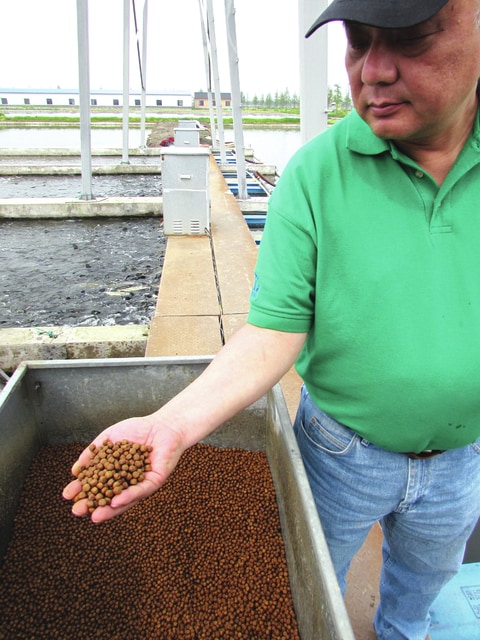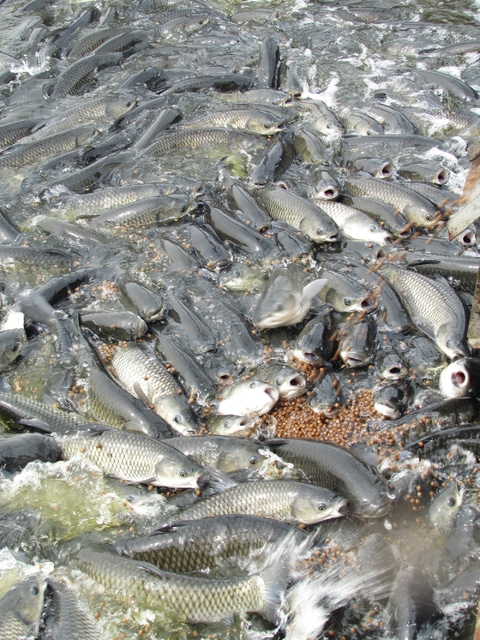

SHANGHAI, CHINA — The hinged door at the bottom of the large aluminum bin opened and thousands of pea-sized pellets spilled out to the hundreds of eager mouths in the water below.
Each of the feed pellets was 50 percent soybean, and the hungry carp splashing in the water of the aquaculture pond were loving every morsel of the soybean protein from America — much of it from Ohio.
Jian (Jim) Zhang smiled as the fish crowded their way to where the fish feed was pouring out in short bursts. “Grass carp are the hogs of the water. They eat it up.”
The aquaculture facility, while almost an hour by highway from the city center, was still technically in Shanghai — the world’s largest city with a population of more than 26 million people.
It is here on the other side of the world, at this fish farm and dozens like it across southeast China, that American agriculture technology meets the ever-growing needs for food in the People’s Republic of China.
A billion bushels head East
Why is this fish farm in southeast China important to Ohio soybean growers?
Consider this: Almost half of the estimated four billion bushels of soybeans grown in America in 2015 were exported. And more than half of those exported soybean bushels — about 1.3 billion — went straight from farms in Ohio and other states right to China.
More than a billion bushels of American soybeans for the approximate 1.4 billion people in China.
Last summer, Highland County soybean farmer Nathan Brown visited aquaculture facilities such as this one in Shanghai and in Vietnam as part of the U.S. Soybean Export Council’s “See For Yourself” program to give American soybean farmers an opportunity to see where and how their exported soybeans are used. Rural Life Today profiled Brown’s trip in an article after he returned.
In April, Rural Life Today had the opportunity to visit aquaculture facilities in southeast China on a similar tour with the help of the same U.S. Soybean Export Council.
Tour guide Zhang is Program Manager for Aquaculture with the U.S. Soybean Export Council. he was more than thrilled to show off the facilities where so much American and Ohio soybeans end up. He hopes a lot more U.S. soybeans are purchased by China in the future. There are about a dozen such “demonstration” fish farms in southeast China partnering with the U.S. Export Council on this American soybean meal and fish farm technology.
“This is called intensive pond aquaculture,” he said, sweeping his arm across the large facility where there are a number of rectangular concrete “cells” of about 20 by 100 feet.
He pointed to one of the workers along the walkway between the cells.
“This gentleman is responsible for the daily management of the feeders in the cells. These are the feeders. The fish we are culturing now is the grass carp, which is the number one fed species in the world. The production of this fish alone annually is about five million metric tons, which equals the total aquaculture production of India. India is the number two aquaculture producer in the world,” he said.
He scooped up a handful of the feed that contained soy and soybean meal. “This contains more than 50 percent soybean meal,” he said.
How many fish are in each of the cells? About 8-9,000 fish in the cell. He said that outside of the cell they have other species of fish that act as cleaners to clean the algae and plankton in the water. It keeps the water more productive. It keeps the water from being too “utropic” — because once the water becomes “Utropic” it will hurt the fish.
He motioned for the American journalist to venture out closer to the fish and the feeder along a narrow walkway with the rows of cells on each side.
“These fish are not scared of people at all. But I don’t know if the fish are scared of Americans or not,” he joked, “because they are Chinese fish.”
The formula
What the fish are eating is a formulated feed, and the formula is American. “A formulated feed needs a mixture, a balance. The protein of this feed is supplied by the soybean meal, then we also have some starch inside so it can be extruded. This feed floats on the water. It doesn’t sink,” Zhang points out.
He said the formula for this feed is provided by the U.S. Soybean Export Council. “We provided the formula and the technology for the farm. By using this technology we can increase production and improve economic efficiency.”
He said that the U.S. Soybean Export Council, by using this feed, can create more demand for soybean products. “It creates more ways for soybeans from the U.S. to come into China.”
Minerals and vitamins are also in the feed. How much of the feed do the grass carp eat? It depends on the water temperature. The grass carp is a warm water fish, and once the temperature reaches 16 degrees Centigrade they feed. The Feed Conversion Rate is 1.8 pounds of feed creates one pound of fish meat, Zhang said.
The feed is given to the fish about every two hours and it is done with a timer. The bins are filled by a conveyor system from inside a building next to the cells.
The fish feed is produced by Chinese fish mills. “We contract with the fish mills to produce the USSEC formulated feed. We call it U.S. Soy Optimized Feed, and since we work for the Soybean Export Council, all of the beans comes from the U.S.”
He said they introduced this technology into the country from the USSEC three years ago. Now this technology is really flourishing. It really helps to solve a lot of problems the Chinese Aquaculture is facing.
When told that Rural Life Today is based in Ohio and much of the soybeans going to China come from Ohio, Zhang mentioned a number of agriculture specialists at Ohio State that he knows and who work with the Chinese. he mentioned one OSU agriculture researcher who had visited the very facility being toured that day.
A native of China, Zhang’s residence is actually in Alabama. “I took my two sons there to Alabama to study,” he said, at Auburn University, where they work with the Chinese on the aquaculture initiatives.
“I got to know the area. I like the greenness, it is very southern. But the younger generation appreciates more the San Francisco area, so my youngest son is going to LA,” he said.
Zhang has been with the Soybean Export Council for 29 years. At the time he started it was the ASA — American Soybean Association. in 1987 as a consultant, and then full time in 1993. “I enjoy this job very much. I have been treated very well by the soybean farmers. This program is very meaningful to both China and the United States.”
Valuable relationship
How meaningful is this U.S. soybean farmer-Chinese buyer relationship to both countries?
Last November, U.S. Secretary of Agriculture Thomas Vilsack visited a port in Guangdong Province, China just to witness a vessel of U.S. Soy Sustainability Assurance Protocol (SSAP) certified sustainable soybeans being unloaded and spoke with USSEC members.
The vessel Delmar was loaded with 59,000 metric tons (MT) or approximately 2.2 million bushels of U.S. SSAP certified sustainable soybeans at the Reserve (Cargill) port, New Orleans, according to the Soybean Council. The exporter is Agrex of Overland Park, Kansas and the importer is Sino Grain.
Since 1995, the U.S. soybean export volume has more than doubled, with the increase in demand from China being the primary catalyst, according to the USDA. However, China’s one-billion-bushel entrance into the U.S. market has come at the expense of other export partners.
For example, USDA’s Foreign Agricultural Service’s Global Agricultural Trade System (GATS) census data reveals that more than 40 countries have reduced their consumption of U.S. soybeans since 1995, representing more than 400 million bushels. More specifically, exports to Japan, South Korea, and Taiwan have declined by nearly 150 million bushels since 1995. The trend toward increased consumption by China and lower consumption by other export partners makes U.S. soybean farmers increasingly reliant on Chinese demand to support domestic markets.
In February, U.S. soybean production for the 2015/16 year was estimated at a record 3.930 billion bushels. USDA’s January, 2016 WASDE report indicated that the latest estimate was cut by 51 million bushels compared to the previous month based on reduced estimated harvest and yield. Harvest declined from 82.4 million acres, the December estimate, to 81.8 million acres. Yield, was lowered 0.3 bushels per acre to 48 bushels per acre.
Even with this decrease, the 2015-16 yield was a record, increasing 0.5 bushels per acre compared to 2014-15. Adding this record production to larger beginning inventories and it ends up expanding the 2015-16 total supply to 4.150 billion bushels, 98 million bushels greater than last year.
The 2015-16 projection for soybean crush, was left unchanged from the December projection and is expected to increase about 1.0 percent to 1.890 billion bushels compared to 2014-15. Soybean exports, on the other hand, are expected to represent 43 percent of the 2015-16 production.
Gary Brock can be reached at 937-556-5759 or on Twitter at GBrock4.



